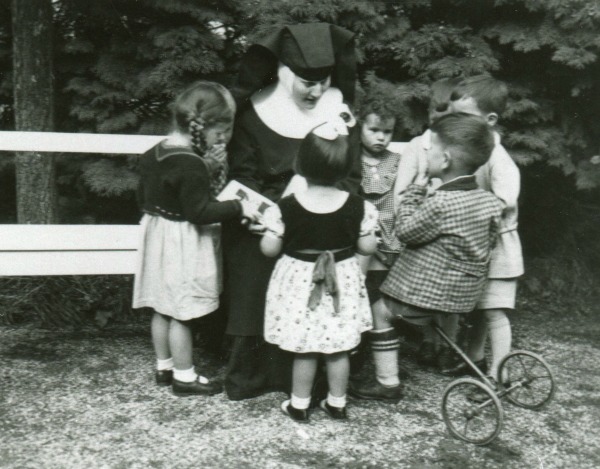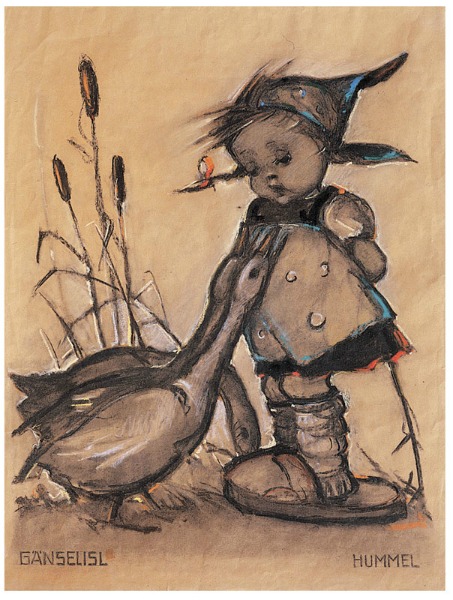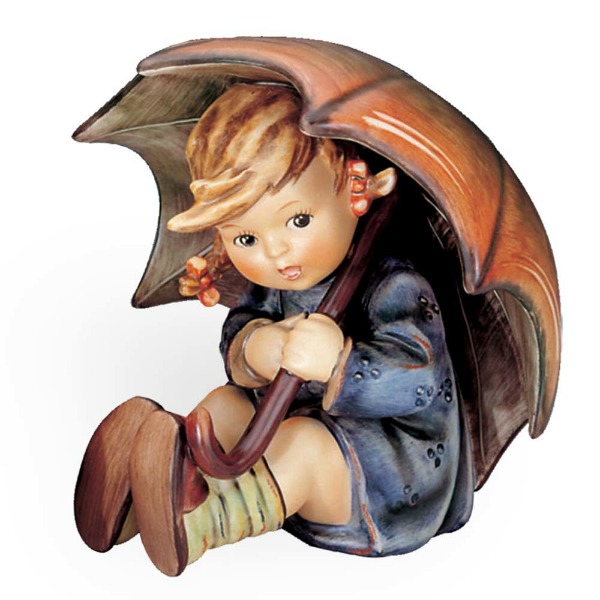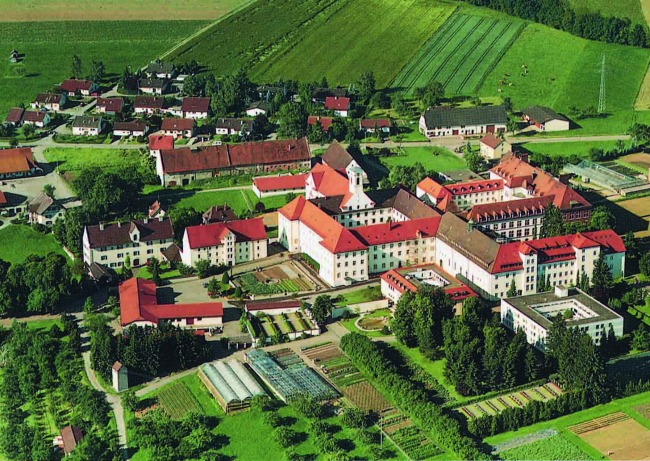Recent Posts
THE M.I. HUMMEL STORY
Posted on
SISTER MARIA INNOCENTIA HUMMEL – AN ARTIST AND HER VISION
Berta Hummel
was born in Bavaria in 1909 with a wonderful gift – an instinct for perceiving her
world and translating her observations into drawings. She grew up in the market
town of Massing, one of six children in a close-knit family that encouraged her
artistic talent. As a school child, Berta was filled with high spirits,
imagination and a soaring sense of creativity. She loved nothing more than to
impress friends and family with quick, deft sketches of flowers and trees,
houses and people, and the busy life she saw around her. Berta’s ability blossomed,
and it was clear she would benefit from advanced artistic training.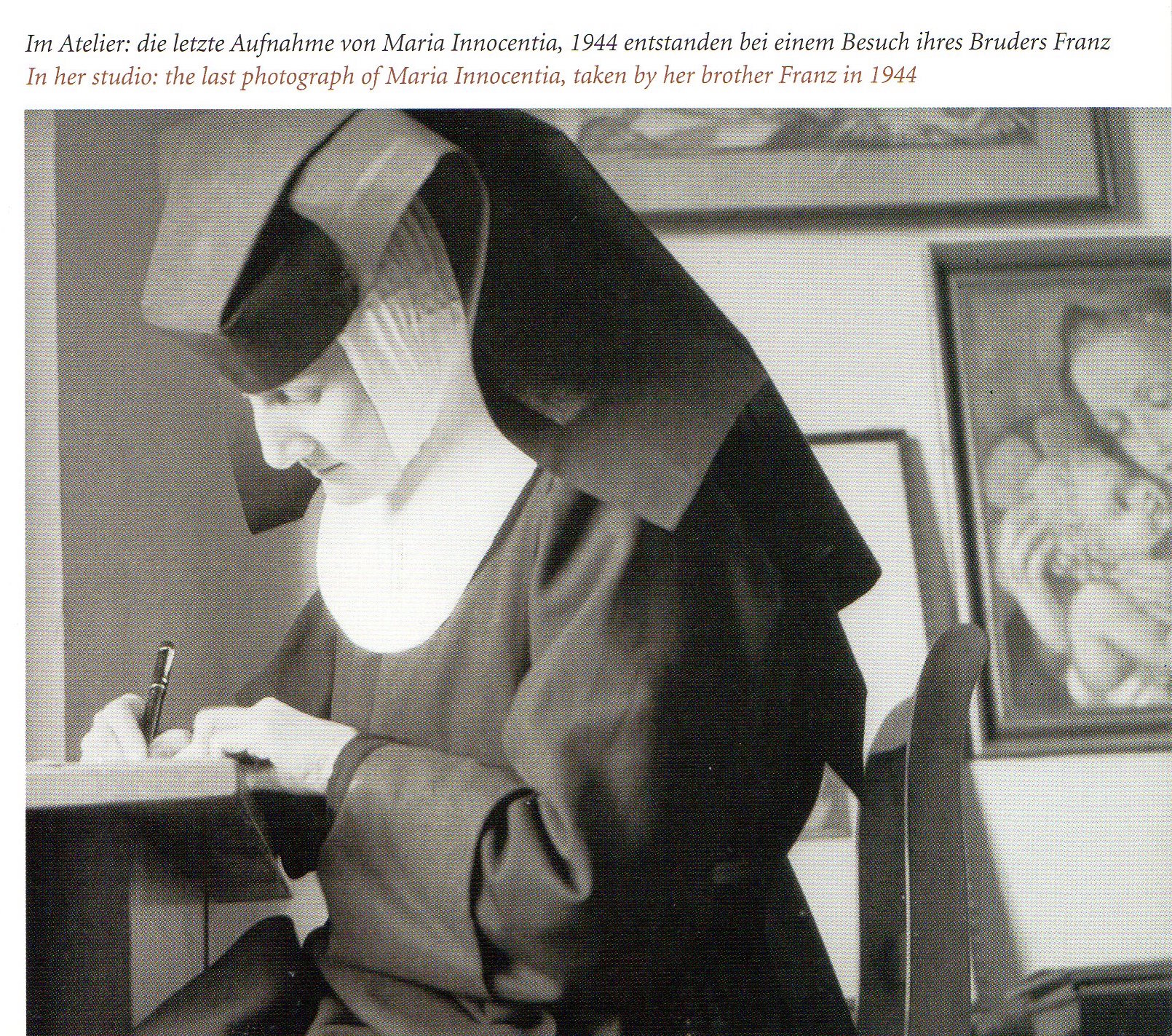
In 1927, the aspiring artist enrolled in Munich’s famed State School of Applied Arts where she underwent rigorous instruction in art history, life drawing, watercolor and oil painting, textile design and other studies, working with noted artists and teachers. Berta graduated at the top of her class and it was hoped she would continue in Munich as a teaching assistant.
Yet Berta made a choice that many found surprising. She entered the Convent of Siessen in 1931, a teaching order in Saulgau that emphasized the arts. Berta had a strict Catholic background, and searching for a higher meaning had always been important to her. As a student she had befriended two Franciscan Sisters who helped guide her toward a life devoted to faith. In 1934, Berta Hummel took her vows along with the name Sister Maria Innocentia Hummel.
As she adjusted to convent life, Maria Innocentia found fulfillment in teaching art to kindergarteners and leading the convent’s Vestments Department, designing clerical robes, church altar cloths and banners. She also began to sketch the endearing pictures of children that would someday make her famous.
These were stylized images of country children going to school, making music, playing simple games. The colors were muted, the style loose and sketchy. And the children were enchanting. Cheeks were plump, hair windswept. Shoes were too big, and socks sagged. The artwork was published in a variety of forms, including postcards, and Sister Maria Innocentia Hummel began to develop a reputation as a fresh talent in the world of religious art.
W. GOEBEL PORZELLANFABRIK – FROM ARTWORK TO FIGURINES
The drawings came to the attention of Franz Goebel, fourth generation head of W. Goebel Porzellanfabrik, a renowned porcelain company in Rödental. Franz was always on the lookout for promising new artists, and it struck him that these simple sketches of children would be the perfect basis for a line of figurines, with special appeal during difficult political times.
Franz Goebel sought permission from the Convent of Siessen to translate the two-dimensional artwork of Sister Maria Innocentia Hummel into three-dimensional ceramic figurines. After some negotiation, it was agreed that the figurines would be true to the artwork and handcrafted to meet highest quality standards, and final artistic control would rest with Sister M.I. Hummel and the convent. With these conditions, Goebel received the exclusive rights to create M.I. Hummel figurines.
Goebel set to work with the artist to develop a figurine collection unlike any other. Sculptors transformed the Sister’s charcoal and pastel drawings, bringing them to life in three dimensions. Painters created a unique palette of colors. Casters experimented with ceramic materials. Porcelain was too delicate for the rough-and-tumble character of these children. Instead, Goebel used earthenware for a warm, homespun affect.
The result: true innovation. M.I. Hummel children were as mischievous as your little brother, cute as the tot next door. They were rascals, like the real kids you remembered from your own childhood, their charm based on simple honesty.
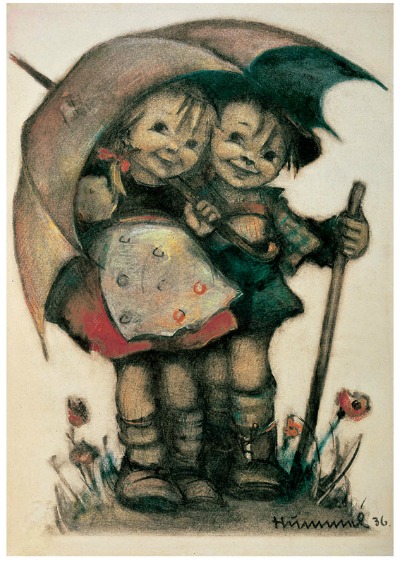
The new figurines were introduced to the world in 1935 at the Leipzig Fair, a major international trade show. M.I. Hummel figurines had instant appeal. Each motif was approved by Sister Maria Innocentia herself, bore a facsimile of her signature, and the stamp of W. Goebel Porzellanfabrik, assuring excellence.
Despite setbacks during World War II, the line flourished and grew in popularity. American G.I.s stationed in Germany following the war sent figurines home to their loved ones as souvenirs, and America’s passion for M.I. Hummel collectibles began.
Sadly, Sister Maria Innocentia Hummel suffered from tuberculosis and died in 1946 at the age of only 37. An Artistic Board at the Convent of Siessen was appointed to carry on her legacy. The Board oversees the creation of M.I. Hummel figurines with care and commitment to this day.
Admiration for M.I. Hummel continues, and the figurines are considered by many to
be the world’s most beloved collectibles. Throughout the years, leadership has
been reorganized and the line has evolved. But some things never change. We
continue to uphold the time-honored standards of excellence established by Franz
Goebel, Sister Maria Innocentia Hummel and the Convent of Siessen more than
eight decades ago. M.I. Hummel works of art still are, and always will
be, grounded in the simple lives and innocent joys of children.
ARS AG - SPREADING ARTISTRY AROUND THE WORLD
In 1933, Josef Müller, the owner of the renowned Catholic publisher, Ars Sacra of Munich, received a letter from the Convent of Siessen, along with drawing samples by one of their novices. The convent was seeking publication of the artwork of the soon-to-be Sister M.I. Hummel.
Ars Sacra immediately recognized the appeal of the artwork. They envisioned turning the drawings into merit pictures for students, art postcards and communion souvenirs. Negotiations with the Convent resulted in the granting of exclusive reproduction rights to artwork created at the convent. By the end of 1933, thirty-seven Hummel pictures had been printed by Ars Sacra.

It was in 1935 that a postcard printed by ARS caught the eye of an astute German ceramic manufacturer. The rest is M.I. Hummel history!
Today, ARS AG, a predecessor of Ars Sacra, is a thriving international licensing company, located in Switzerland. ARS AG continues to hold the worldwide rights to the original 2-dimensional artwork as well as to photographs of M.I. Hummel figurines. Their customers are manufacturers worldwide who showcase Hummel artwork in gifts and collectibles, home décor products, books, stationery, crafts, games, toys, apparel and jewelry. For eight unbroken decades, ARS has been sharing the joy of Sister M.I. Hummel’s vision with the world.
HUMMEL MANUFAKTUR – COMMITED TO EXCELLENCE
The M.I. Hummel manufacturing operation in Germany is known as Hummel Manufaktur. M.I. Hummel figurines continue to be handcrafted in the same Rödental location where they’ve been made since 1935. Many of the dedicated artisans have been working on M.I. Hummel figurines for decades, and time-honored methods of the past are still utilized.
There are a number of basic steps in the creation of M.I. Hummel figurines:

SCULPTING
- A clay model is presented to the Artistic Board at the Convent of Siessen.
- The model is altered as necessary based on the Board’s critique.
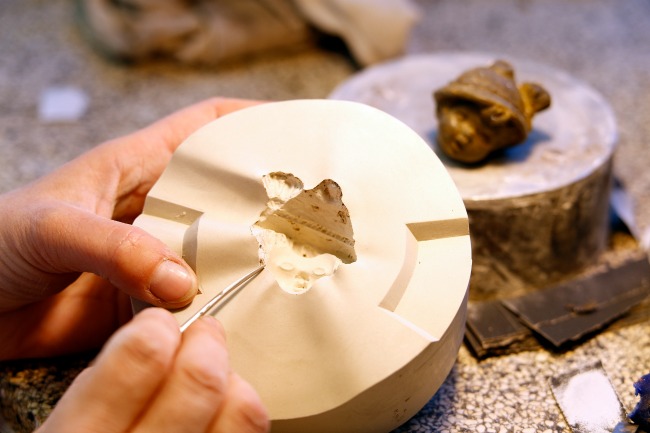
MOLDMAKING
- Once approved, the sculptor and master moldmaker determine where the figurine should be cut. As many as 40 pieces may be required for production.
- Plaster of Paris is poured over the clay pieces to make the master mold.
- A series of positive and negative molds lead to the creation of a durable acrylic resin working model.
- From the working model, a plaster working mold is made. It can be used only for a limited time before eroding. New working molds are created from the working model as needed.
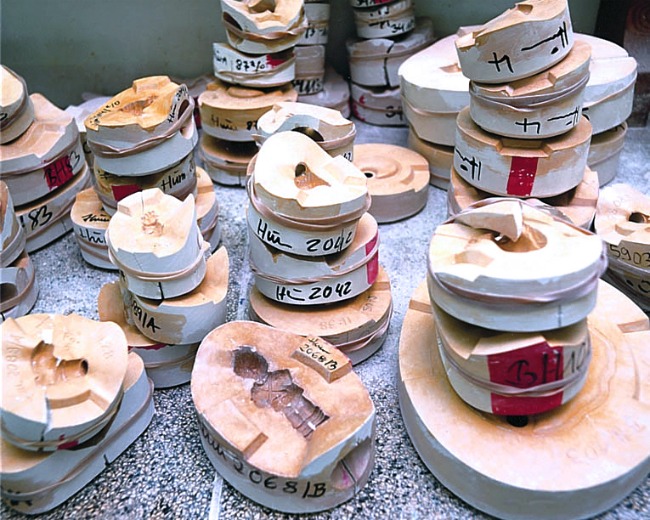
Note about Hummel Mold numbers: M.I. Hummel figurines are made with numbered molds. The mold number, also known as the HUM number, is generally incised as an identifier on the based of the figurine, followed by a slash and numerals that serve as size designators.
CASTING AND ASSEMBLING
- Liquid slip, composed of kaolin, feldspar, clay, quartz and water, is poured into the working molds, creating the shell of the figurine.
- The pieces are assembled using the slip, then smoothed to remove seams.
FIRING
- The first firing is at 2100°F. The figurines shrink in size and emerge with a powdery white finish.
- Figurines are dipped and sprayed with a tinted liquid glaze.
- The second firing is at 1870°F. Glazed figurines are white and coated with a transparent skin of glass.
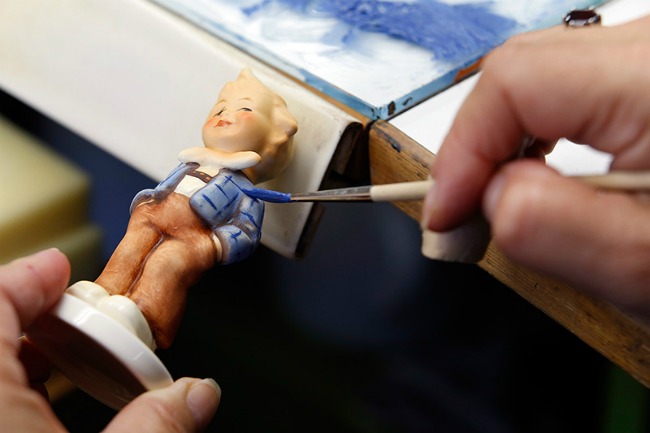
DECORATING
- More than 200 colors approximate the palette used by Sister M.I. Hummel, made of metallic oxide powders mixed with balsam oil and turpentine.
- A decorated sample is prepared and approved by the convent for the painters to follow.
- Figurine faces are painted by specially trained artists.
- Final firings at 1407°F fuse the color to the ceramic surface.
THE M.I. HUMMEL CLUB – SHARING THE LOVE
The M.I.Hummel Club is a distinguished group with members around the world, united by a common bond – the love they share for the tradition and artistry of M.I. Hummel figurines. Now in its 40th year, the Club began operating in North America in 1977 as the Goebel Collector’s Club, founded to unite, educate and uphold the interests of a growing number of M.I. Hummel enthusiasts.
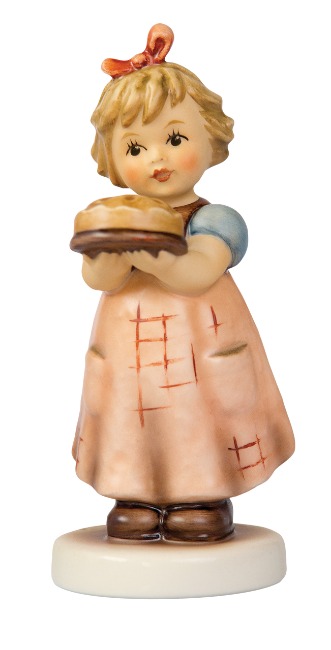 The idea was
that the more you know about a hobby the more fun it can be, and the response
was unprecedented. By 1989, the Club was renamed the M.I. Hummel
Club and became an international organization. It was the world’s first
collector’s club and continues to be the foremost organization of its kind.
The idea was
that the more you know about a hobby the more fun it can be, and the response
was unprecedented. By 1989, the Club was renamed the M.I. Hummel
Club and became an international organization. It was the world’s first
collector’s club and continues to be the foremost organization of its kind.
The benefits of belonging have evolved through the years. Some of the features that members most enjoy are a complimentary M.I. Hummel gift figurine every year they continue with the Club. There are opportunities to purchase special Club Exclusive figurines created just for members. A quarterly magazine, INSIGHTS, keeps members up to date and involved with M.I. Hummel history, topics and traditions. And special offers and discounts make membership an important way to save.
Many members enjoy the personal camaraderie that’s an informal Club benefit. From conventions in cities around the country to a European travel program, there are plenty of chances to meet and mingle with fellow members. And for those who desire more frequent contact, there’s a thriving network of Local Chapters across the country, with members meeting regularly to share their knowledge, enjoy friendships and serve their communities.
DAS BERTA HUMMEL MUSEUM IM HUMMELHAUS – A FAMILY TRADITION
The Hummels hail from Massing, Germany, a market town in southern Bavaria. They’ve always been a family of merchants, running a general store on the town square that has provided a livelihood for generations.
In 1909, Berta Hummel was born in the home above the store. She eventually became known as Sister Maria Innocentia, the famed artist whose work inspired M.I. Hummel figurines. To honor her artistic legacy, Berta’s nephew, Alfred Hummel, founded Das Berta Hummel Museum Im Hummelhaus in 1994 in the place she was born.
Today, under the direction of Alfred and his daughter, Veronika, the museum houses an extensive collection of paintings and drawings by the artist from her student years, before she entered the Convent of Siessen. Visitors can also see the largest exhibit of M.I. Hummel figurines in Europe, as well as special exhibits by other well-known artists. Guided tours are available by appointment. Visit hummelmuseum.de for information.
THE CONVENT OF SIESSEN – A PLACE OF PEACE AND INSPIRATION
On a hillside in southern Germany, three kilometers outside of the town of Saulgau, there is a place of quiet dignity that for seven and a half centuries has been home to a convent. Siessen began in the year 1259 when a local nobleman bequeathed part of his lands to a group of Dominican nuns. Through the years the convent expanded, periodically suffering the affects of fire and war. During a prosperous time in the eighteenth century, a magnificent Baroque church, St. Marks of Siessen, was erected on the site, designed by the famous Zimmermann brothers.
The Dominican order declined at Siessen during the nineteenth century, and the Franciscans negotiated to take over the convent. When Berta Hummel arrived there in 1931, she joined a thriving Franciscan order with a focus on teaching and the arts. The artist that inspired M.I. Hummel figurines lived and worked at Siessen for fifteen years, and passed away there in 1946.
Visitors today can enjoy the Baroque Church of St. Marks, stroll the convent gardens and see the final resting place of Sister Maria Innocentia Hummel. Tours are available of Hummelsaal (Hall of Hummels), an exhibit of original drawings and paintings completed at the convent by Maria Innocentia including her famous “Way of the Cross” paintings, located in a special chapel. For information, visit klostersiessen.de.
When you add a Hummel figurine to your home you are bringing home a piece rich in history.
 Loading... Please wait...
Loading... Please wait...

